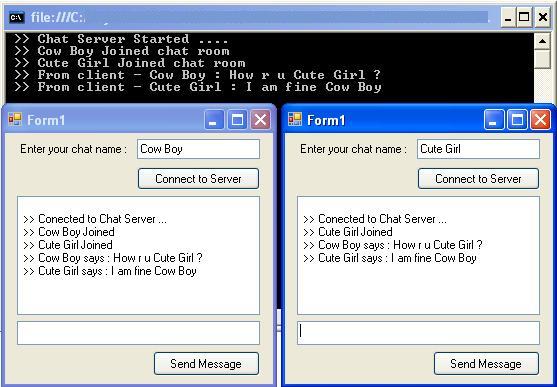A tutorial on Chat Server and Chat Client in VB.net
By: Issac in VB.net Tutorials on 2009-02-22
Multithreaded Socket Programming is the basic idea behind a TCP Chat Server communication. A Multithreaded Server Socket Program communicates with more than one Client at the same time. But there the communication is happening only between Server to Client or Client to Server, there is no communication between Client to Client. In a Multithreaded Chat Server, a Client can communicate with any number of Clients, currently connected on the Chat Server.

Each Client sends messages to the Server and the Server broadcasts the message to all Clients that are currently connected to the Chat Server. From the following figure you can see how a VB.NET TCP Chat Server is handling communication between Client to Client.

How to run Chat Server program?
After creating the Chat Server and Chat Client programs we have to run the Server program first and then run the Client program. In the Client program enter a Chat name and click the "Connect to Server "button. Then you can see the message in the Server program User Joined Chat Room. Similarly you can connect more than one Client at the same time and start chatting each other. It is better to Compile and Build the program and run from the .exe files.
Sample Code for Chat server in VB.net
Sample Code for Chat client in VB.net
Add Comment
This policy contains information about your privacy. By posting, you are declaring that you understand this policy:
- Your name, rating, website address, town, country, state and comment will be publicly displayed if entered.
- Aside from the data entered into these form fields, other stored data about your comment will include:
- Your IP address (not displayed)
- The time/date of your submission (displayed)
- Your email address will not be shared. It is collected for only two reasons:
- Administrative purposes, should a need to contact you arise.
- To inform you of new comments, should you subscribe to receive notifications.
- A cookie may be set on your computer. This is used to remember your inputs. It will expire by itself.
This policy is subject to change at any time and without notice.
These terms and conditions contain rules about posting comments. By submitting a comment, you are declaring that you agree with these rules:
- Although the administrator will attempt to moderate comments, it is impossible for every comment to have been moderated at any given time.
- You acknowledge that all comments express the views and opinions of the original author and not those of the administrator.
- You agree not to post any material which is knowingly false, obscene, hateful, threatening, harassing or invasive of a person's privacy.
- The administrator has the right to edit, move or remove any comment for any reason and without notice.
Failure to comply with these rules may result in being banned from submitting further comments.
These terms and conditions are subject to change at any time and without notice.
- Data Science
- Android
- React Native
- AJAX
- ASP.net
- C
- C++
- C#
- Cocoa
- Cloud Computing
- HTML5
- Java
- Javascript
- JSF
- JSP
- J2ME
- Java Beans
- EJB
- JDBC
- Linux
- Mac OS X
- iPhone
- MySQL
- Office 365
- Perl
- PHP
- Python
- Ruby
- VB.net
- Hibernate
- Struts
- SAP
- Trends
- Tech Reviews
- WebServices
- XML
- Certification
- Interview
categories
Related Tutorials
Changes in Controls from VB6 to VB.net
Unstructured Exception Handling in VB.net
Structured Exception Handling in VB.net
Creating Sub Procedures in VB.net
Passing a Variable Number of Arguments to Procedures in VB.net
Specifying Optional Arguments with default values in Procedures in VB.net
Preserving a Variable's Values between Procedure Calls in VB.net
Throwing an Exception in VB.net
Comments